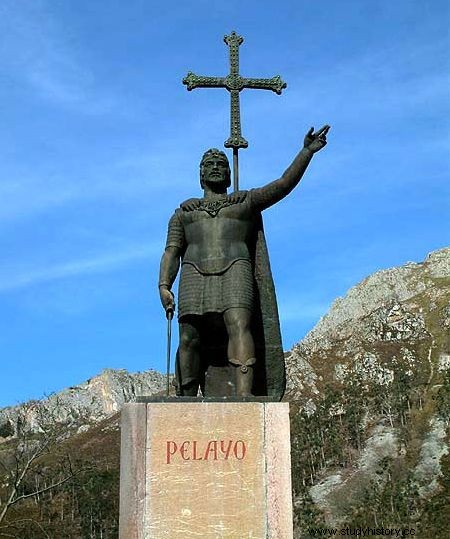Don Pelayo Asturian king. His origins are uncertain, it is believed that he was the son of a Gothic nobleman named Fávila.

During the reign of Witiza he fell out with the Gothic king (the reasons are unknown) and "exiled" to the North, where the Goths never came to control the area. This is the first contact with the Asturian clans. It is known that he even made a pilgrimage to the Holy Land and that he returned when Don Rodrigo was crowned monarch after defeating the sons of Witiza. The new monarch named him espatario, a member of the royal guard. He fought alongside the king at the battle of Guadalete. After the defeat in 711, Pelayo was able to escape with a group to Toledo, the capital of the Visigothic kingdom. In 712 Toledo surrendered without resistance and Don Pelayo left the capital with his man escorting Urbano, Archbishop of Toledo, who guarded the sacred Christian relics. He settles on the Cantabrian coast and his first task is to try to attract the brave mountaineers to his cause. The Asturian and Cantabrian people lived in clans scattered throughout the mountains with a great sense of independence (widely demonstrated against the Romans).
In the year 714, the Muza expedition reached León, Astorga and Lugo, leaving a small garrison in Gijón under the orders of Munuza. It is believed that Munuza and Don Pelayo established contact. In the year 718 Don Pelayo appears in Córdoba, we do not know if as an ally or as a hostage, the fact is that on his return to the North, this same year, taking advantage of a meeting in Cangas de Onís by the most important mountain clans, he is crowned king – It is also believed that he had something to do with Munuza's "alleged" infatuation with Don Pelayo's sister. Don Pelayo with this appointment sought to unify the command and establish a hereditary monarchy, since he had suffered in his flesh the succession problems of the Visigoths, whose monarchy was elective.
His first steps were aimed at preparing the resistance. In the year 722, after some skirmish, Governor Munuza requested support and a column of about 20,000 men?, led by Alqama, arrived from the South. Alqama was accompanied by Bishop Oppas, Agila's uncle and Wiitza's brother, to try to negotiate with the rebels. Don Pelayo knew that he had to lead the Muslims to a favorable terrain for them and he did so by taking refuge on Mount Auseva in the Picos de Europa. Alqama sent Opas to negotiate with Don Pelayo and he reproached him for his betrayal.
I have found a stubborn man, all that remains is to fight
Opas reported to Alqama.
we'll crush those 300 wild asses
Alqama replied. Giving the order to attack.
Don Pelayo had ordered his "300" men around the Cova Dominica, future Covadonga, with a small group barricaded inside. When the Muslims tried to access the cave through the gorge they received a shower of stones and arrows from the highlands dominated by the Astures. From this very favorable position, the Astures inflicted heavy losses on the Muslim vanguard, the emboldened Astures came out of their positions and attacked the retreating Muslims. A rockfall buried part of the army, even Alqama dying. Legend has it that there was divine intervention in this victory, which is why Covadonga was subsequently consecrated as a place of worship and pilgrimage for Christianity. Munuza, aware of the defeat, left Gijón heading with his troops to León.
Don Pelayo became strong in this area and after his death in 737, his son Fávila inherited the Asturian throne. Little could he enjoy his reign, because a bear killed him on a hunting day.
The legend according to the Christian version is more or less as we have tried to tell it, but the Muslim version speaks of a small skirmish in which it was not worth investing more efforts or resources.

To learn more:The Southern Crusade – Juan Antonio Cebrián, Heroes – Enrique de Diego, Historical Atlas of Spain – v.v. a.a., Don Pelayo – José Ignacio Gracia

